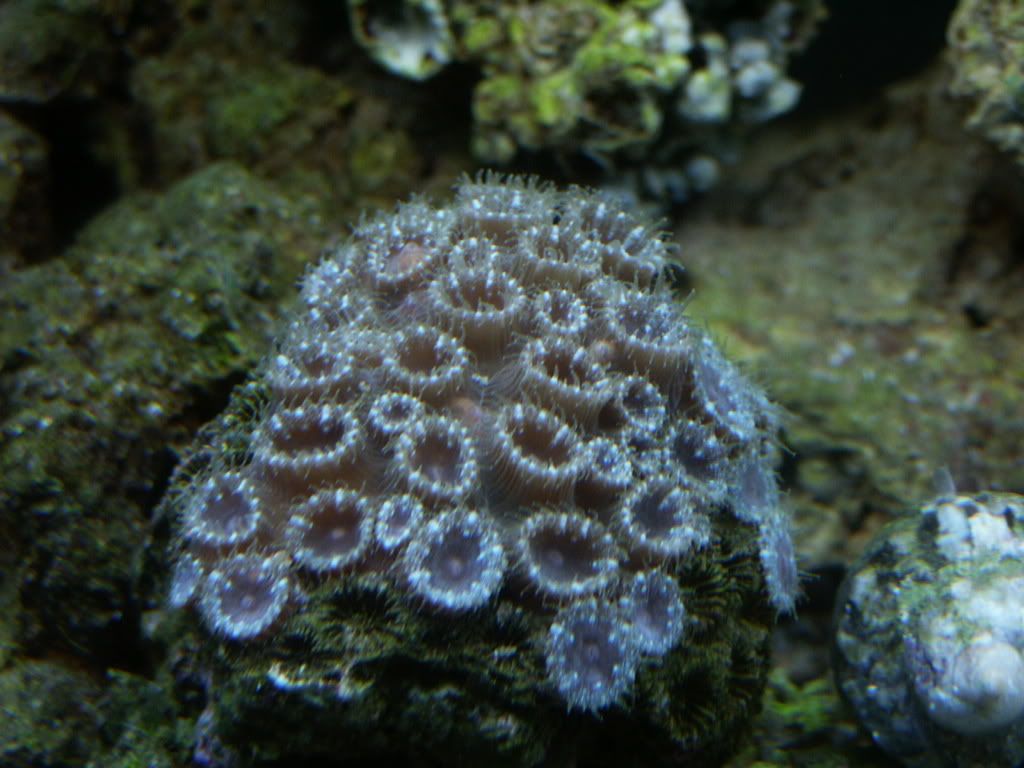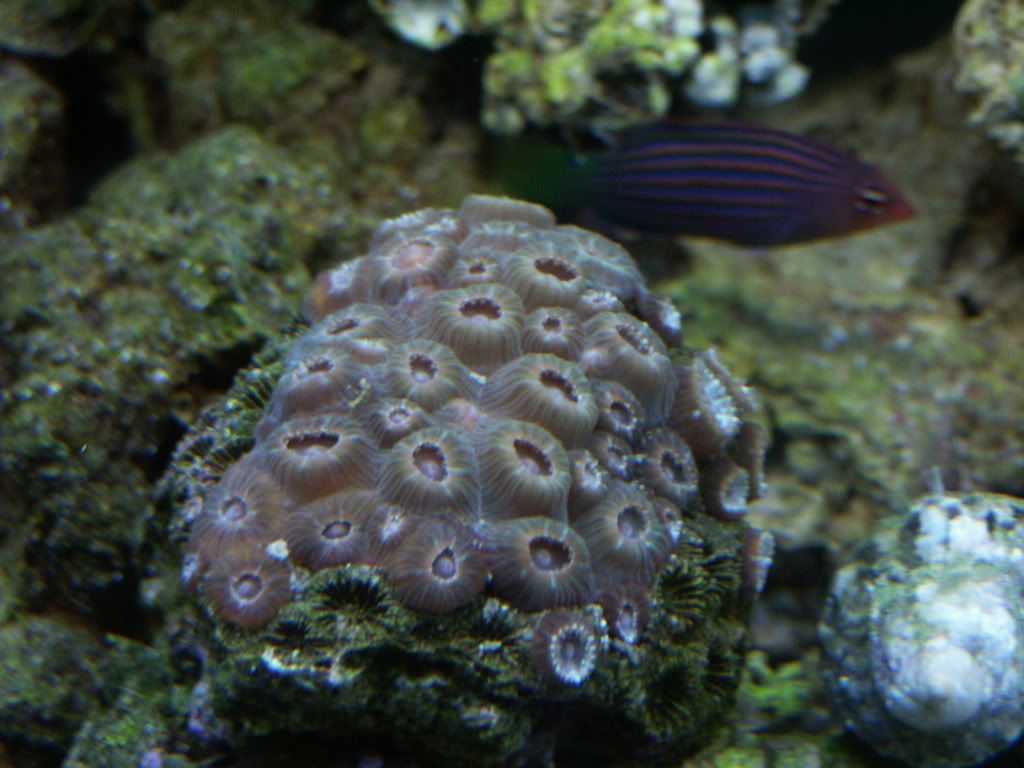

|
|
|
#1
|
|||
|
|||
|
Is this a coral??
http://i259.photobucket.com/albums/h...n/PICT0013.jpg
I got it when i bougth all my LR and thought it looked cool then it started getting these little pink and now turning green things on it one at a time. And it is still growing more! |
|
#2
|
|||
|
|||
|
Reminds me of flowerpot goniopora.
|
|
#3
|
|||
|
|||
|
Me too
__________________
Chaeto 2, Nitrates 0 |
|
#4
|
|||
|
|||
|
So is this a yes or what because i dont know the names of all of these yet and i have looked for it but nothing directly matches the look of it.
__________________
Lovin Life without females |
|
#5
|
|||
|
|||
|
yea looks like coral, the skeleton tells me it's a goni, but it really doesn't look like one to me...
|
|
#6
|
|||
|
|||
|
Yes it is a coral. Looks like some sort of lps. I have one on a piece too, can't recall the name.
|
|
#7
|
|||
|
|||
|
yep its a stony....i dont think its a goni...the voices in my head say montistrea/faviid
__________________
shaun golden- reef aquarium society of charlotte-www.rasoc.org |
|
#8
|
|||
|
|||
|
I think it looks more like a faviia that is feeding with its sweeper tenticals out.
__________________
Click the red house to see my 90 SPS build. Always accepting frags!! |
|
#9
|
|||
|
|||
|
Im just confused
__________________
Lovin Life without females |
|
#10
|
|||
|
|||
|
Im just tryin to find out what it is because like i said, i got it DEAD in a live rock batch from my LFS and I got it to grow. But for some reason (most comments about it) I dont think its growing back to what it was, I think its growing something new. Should I try to take more pics of it like the bottom of it maybe some closer shots(which is hard) and maybe with the polyps closed? Should I put it in the Guinness Book Of Most Retarded Corals?
__________________
Lovin Life without females |
|
#11
|
|||
|
|||
|
I would let it develope a bit, as it is definitely on the heal. Could be a Galaxia or Favid. Give it time to get good and healthy.
Nice save!
__________________
Jamie V. Cologne |
|
#12
|
|||
|
|||
|
i'd take some pics with the polyps closed. also turn down the white balance on your camera so we can see the coral a little better. but no it is not a new different coral growing over. more likely it is the same coral as the previous skeleton and is growing back over its dead parts. it wasnt completely dead when you got it so if you got it for the LR price i would say good find...
|
|
#13
|
|||
|
|||
|
Quote:

__________________
we DO NOT feed the blastos!!!! |
|
#14
|
|||
|
|||
|
So here is the updated photo(better) with open and closed polyps
open:  closed: 
__________________
Lovin Life without females |
|
#15
|
|||
|
|||
|
What you have is a Montastrea, possibly M. curta. This group of Favids is distinquished by extratentacular budding, which is to say, the new daughter polyps develope between the others, rather than an adult polyp dividing in the middle (typical of Favia, Favites) Do you know where this cral came from? There are Atlantic and Pacific species of the genus. Also, how large are the individual adult corallites?
__________________
Jamie V. Cologne |
|
#16
|
|||
|
|||
|
I dont know where it came from and are you asking about the ones that are forming by themselves with no other polyps around them. If so they are about 1'4INCH in diameter and some are even smaller
__________________
Lovin Life without females |
|
#17
|
|||
|
|||
|
i believe he is asking about how big is the biggest polyp/ the adult polyps or coralites.
|
|
#18
|
|||
|
|||
|
what about Oculina Patagonica--- Sorta looks like it.. Calfo's new book has some info about Oculina sp. Unfortunately I dont have it handy...
from aims:  
__________________
----------------------- Matt DVRC President Prop&Save! ...Sure don't know what I'm going for, but I'm gonna go for it for sure... |
|
#19
|
|||
|
|||
|
On second thought, Diploastrea Heliopora...My #2 choice. Its definetly not a goni...not even close.
__________________
----------------------- Matt DVRC President Prop&Save! ...Sure don't know what I'm going for, but I'm gonna go for it for sure... |
|
#20
|
|||
|
|||
|
OK, what I'm going after is the diameter of a single coralite. If they are 1/4 inch, which is about 6mm, then it belongs to the smaller polyped species of Montastrea. M. curta is the most likely species. It fits the size and extratentacular budding.
For the record, Diploastrea species do not have extratentacular budding. Oculina has a different skeleton. It is an interesting, if somewhat common coral. It is often a dominant species of certain reefs.
__________________
Jamie V. Cologne |
|
#21
|
|||
|
|||
|
Oculina has branching forms and one encrusting form. It is also has a very tiny corallite.... I have seen single polyps come in on LR and some caribbean corals. I have never seen one turn into a colony though. They were always about 1/4" to 3/8" and yellow to brown...
My vote is still for oculina! 
__________________
----------------------- Matt DVRC President Prop&Save! ...Sure don't know what I'm going for, but I'm gonna go for it for sure... |
|
#22
|
|||
|
|||
|
Yea they are all about 6 cm and just out of curiosity do you think it will fill out?
__________________
Lovin Life without females |
|
#23
|
|||
|
|||
|
I think you mean 6 mm, not cm, but, yes, they will eventually recover the naked skeleton. They will overlayer the existing skeleton with new and colonize it further. It takes time. I have one Favid, a Favia, that was damaged and it required a good year to recover completely.
__________________
Jamie V. Cologne |
|
|